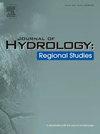揭示墨累达令盆地近二十年来的蒸散模式
IF 5
2区 地球科学
Q1 WATER RESOURCES
引用次数: 0
摘要
研究区域:澳大利亚墨累达令盆地。实际蒸散发(AET)在流域水分平衡中起着关键作用,影响着灌溉和其他用途的水分可用性。了解土地覆盖和气候变化下MDB的AET动态对于确保该地区经济和生态系统的长期可持续性至关重要。我们利用高分辨率土地覆盖数据,结合MODIS和CMRSET AET数据集,在2001年至2020年的MDB和子集水区尺度上进行研究。在MODIS和CMRSET中都观察到东-西AET梯度强烈减小,并且与降雨(P)模式密切相关。CMRSET模式显示出更强的相关性和更真实,而MODIS模式低估了AET。AET的变化顺序为自然陆生植被(NTV) >; 人工陆生植被(CTV) >; 自然裸地(NS),但P是AET变化的主要驱动力。AET/P在干旱区表现出较大的空间变异性,主要受降水和短暂植被响应的驱动。然而,一些流域土地覆被之间的AET和AET/P在统计上没有差异,这表明存在重要的混淆因素。AET/P的实例 >; 1反映了补充水源的利用和以前湿润年的水分携带,表明不同景观对干旱的恢复能力。本文章由计算机程序翻译,如有差异,请以英文原文为准。
Uncovering evapotranspiration patterns in the Murray Darling Basin over two decades
Study Region
The Murray Darling Basin (MDB), Australia.
Study Focus
Actual evapotranspiration (AET) plays a critical role in the basin's water balance, influencing water availability for irrigation and other uses. Understanding the dynamics of AET in the MDB under changing land cover and climate is essential for ensuring the long-term sustainability of the region's economy and ecosystem. We do this utilising high-resolution land cover data in conjunction with MODIS and CMRSET AET datasets at the MDB and sub-catchments scale from 2001 to 2020.
New Hydrological Insights for the Region
A strongly decreasing east-west AET gradient is observed in both MODIS and CMRSET and is aligned closely with rainfall (P) patterns. CMRSET patterns demonstrated a stronger correlation and are more realistic, while MODIS underestimates AET. AET follows the order Natural Terrestrial Vegetation (NTV) > Cultivated Terrestrial Vegetation (CTV) > Natural Bare Surface (NS), but P acts as the main driver of AET variability. AET/P shows greater spatial variability in arid regions, driven by episodic rainfall and ephemeral vegetation responses. However, a statistical absence of differences in AET and AET/P between land covers for some catchments indicates important confounding factors. Instances of AET/P > 1 reflect the use of supplementary water sources and moisture carryover from previous wet years, indicating the resilience of different landscapes to drought.
求助全文
通过发布文献求助,成功后即可免费获取论文全文。
去求助
来源期刊

Journal of Hydrology-Regional Studies
Earth and Planetary Sciences-Earth and Planetary Sciences (miscellaneous)
CiteScore
6.70
自引率
8.50%
发文量
284
审稿时长
60 days
期刊介绍:
Journal of Hydrology: Regional Studies publishes original research papers enhancing the science of hydrology and aiming at region-specific problems, past and future conditions, analysis, review and solutions. The journal particularly welcomes research papers that deliver new insights into region-specific hydrological processes and responses to changing conditions, as well as contributions that incorporate interdisciplinarity and translational science.
 求助内容:
求助内容: 应助结果提醒方式:
应助结果提醒方式:


